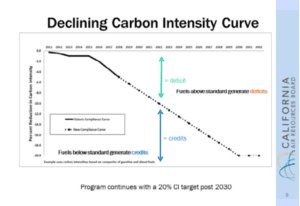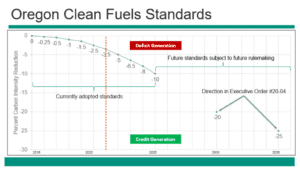
It’s an unbeatable opportunity: you register your electric equipment or EV fleet in your state’s clean fuel program. Then, with zero change to your operations, you receive a check for charging your equipment once per quarter. Clean fuel programs provide a new revenue stream for clean fuel fleets to expand their eMHE, eCHE, EV fleets or otherwise pursue green transportation-related initiatives. But where does the money come from since these programs are not taxpayer funded? We’ll explain how clean fuel program funding works after a brief overview of what clean fuel programs are.
California, Oregon, and soon, Washington (program launching January 2023) have clean fuel programs that all function in an identical way and are designed for the same purposes. Clean fuel programs encourage the decrease of the carbon intensity of their state’s transportation fuel pool and provide an increasing range of low-carbon and renewable alternatives. These programs also encourage the use of cleaner low-carbon transportation fuels and the production of those fuels, therefore decreasing petroleum dependence in the transportation sector as well as achieving air quality benefits.
California’s program is called the Low Carbon Fuel Standard (LCFS), with a goal to reduce the carbon intensity of transportation fuels by 20 percent relative to 2010 by 2030 (though likely to be strengthened in the near future).
Oregon’s program is the Clean Fuels Program (CFP) with a goal of reducing carbon intensity by 10 percent from 2015 levels by 2025.
Washington’s impending program is the Clean Fuel Standard (CFS) which requires fuel suppliers to gradually reduce the carbon intensity of transportation fuels to 20 percent below 2017 levels by 2038.
Clean fuel program funding is based on a fairly simple market supply-and-demand approach. The LCFS standards are expressed in terms of “carbon intensity” (CI) of gasoline and diesel fuel and their respective substitutes.
The carbon intensity scores assessed for each fuel are compared to a declining CI benchmark for each year. Low carbon fuels below the benchmark generate credits, while fuels above the CI benchmark generate deficits. Credits and deficits are labeled in metric tons of greenhouse gas (GHG) emissions.
Over time, fuels with stable carbon intensity scores will either generate more deficits (i.e. gasoline and diesel) or less credits (i.e. zero-emission electricity), creating increased buy pressure on clean fuel program credits.
Clean fuel programs are NOT funded publicly through tax dollars. These programs operate as an open market, where clean fuels generate credits and fossil fuels generate deficits. The funding of these programs comes from regulated entities which need to purchase the credits to offset their deficits. These deficit generators are oil and gas companies that produce, import, and blend fossil fuels. The market, which fluctuates like all markets, dictates that quarter’s credit price. Credits are currently traded over the counter (OTC) and forward-contracted for multiple year terms. Learn more about what factors influence LCFS credit prices in our blog.

Graph credit the California Air Resources Board

Graph Credit Oregon Department of Environmental Quality
If you partner with eMC, we will enroll your organization in your state’s clean fuel program then manage all quarterly reporting to the designated state agencies. The state confirms your energy consumption data and then issues the credits. eMC then trades your credits on the open market and then distributes the credit revenue quarterly to our partners. We do this without any changes to your operations.
To learn more about how you can participate in clean fuel programs in your state, contact us today.